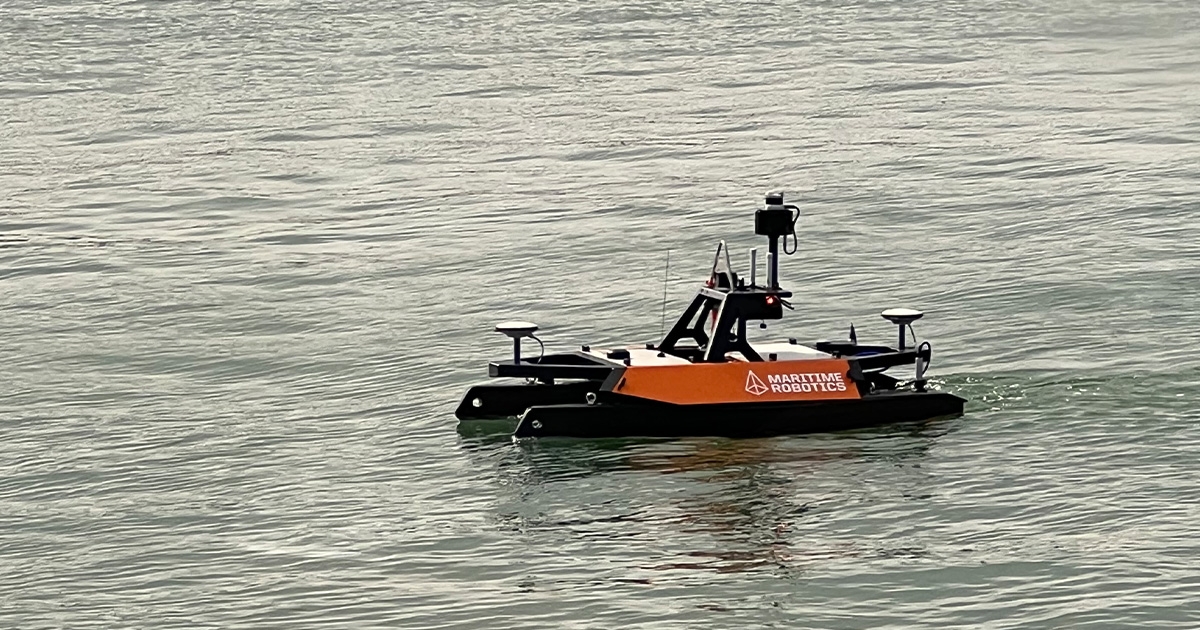Check the Tech: Back to Ocean Business

From April 18 – 20, the National Oceanographic Centre (NOC) in Southampton, UK, once again played host to the ocean industry’s cannot-miss exhibition and conference, Ocean Business 2023.
Diversified Communications, the event organizer, has since reported record crowds—more than 5,000 attendees from over 80 countries and 300 exhibiting companies.
Returning to its more familiar springtime slot—the first edition since the out-of-season and rather pandemic-pinched autumn 2021 event—visitors were spoiled by three sun-filled days (anything but a given on the UK’s south coast) during which ocean tech couldn’t fail to dazzle.
MANAGING AUTONOMY
Interactive booths and dockside demos often eclipse some of the less tangible discussions that frame ocean tech conferences—hardly a surprise given the engineering might on display—but Tuesday’s Sustainability for our Oceans Conference demands reflection. Delegates from all corners of the ocean community gathered in the NOC’s Henry Charnock Lecture Theatre to contemplate the current trends and pressing challenges facing technology development in a “changing” climate. The consensus was that an open dialogue and collaboration to building an “Ocean Enterprise” would remain key, but its import ever more heightened in the age of autonomy. Managing autonomy would dominate the rest of the day’s conversation.
Following presentations from UTEC, Exail, and Sonardyne—a collage of validated use cases for uncrewed vehicles—it was time to pick the minds of representatives from the UK’s Maritime and Coastguard Agency and Lloyd’s Register and better understand the ongoing process to establish the appropriate standards and unfolding permitting procedures for such craft. The Pan-Sector Workshop went on to identify, among other things, what the maritime industry could learn from the aviation market in its integration of autonomous systems.
An emerging thread was the stark reality that amid the rapid diversification of uncrewed assets, whether above, on, or below the waterline, more investment was needed (perhaps counterintuitively) in people. This was the focus of the final session, which stressed the urgency to attract, engage, and inspire future generations to the ocean sector, an enduring mission that was conveniently backed by a three-day Ocean Careers Programme running alongside the Ocean Business 2023 agenda.
EXHIBITION HALL
And so, to the showroom, and a colorful snapshot of an industry keen to capitalize on new technical innovations and integrate novel technologies into traditional ways of working. The buzz on the exhibition floor was palpable and, as tradition dictates, was made ever the more animated by a series of product launches, including Valeport’s 6,000 m SWiFT profiler, Blue Robotics Blueboat USV, and Sonardyne’s Origin 600 ADCP. New partnerships were also forged, including a significant collaboration between Saildrone and Seabed 2030 to accelerate global USV mapping ambitions.
ON THE WATER
USV technology continues to grab industry headlines and, arguably, the show in Southampton. With no shortage of USV platforms on display, Maritime Robotics ran a series of real-time deployments of their compact Otter Pro USV to show its seamless compatibility with KONGSBERG, Teledyne, and Norbit multibeam sonars. The Norway-based company also revealed details of its multipurpose, 9-meter, long-endurance Mariner X USV, fitted with a GNSS Compass, Class B AIS, Cameras, WiFi and LTE Modem, and a deck space for mounting of custom payloads.
CHCNav also had a number of USV units on site, including the APACHE6, a fully integrated lightweight platform optimized to support a NORBIT multibeam and LiDAR, making it a cost-effective, turnkey solution for rapid bathymetric survey.
BELOW THE WATER
It was aboard the RV Callista that onlookers got to sample Del Mar Oceanographic’s (DMO) Wirewalker, a mobile vertical profiling system powered solely by surface waves. A length of wire is suspended from a small surface float, and at the deep end, a weight encourages the wire to move vertically, allowing the profiling system to ride the wire until the Wirewalker meets a mechanical turnaround bumper which in turn releases the cam, releasing the profiler to return to the surface. Sensor agnostic and able to support large custom payloads, the simplicity of the Wirewalker—no batteries required and a 500+ m depth range at a rate of 10 m per second—belie its broad range of applications.
TEST TANK
At the test tank, there was something of an ON&T exclusive, a 1-2-1 look at a brand-new observation class ROV—straight out of the box and yet to be officially launched—from Canadian outfit Deep Trekker. The Photon ROV is a highly mobile (one-case portability unit built on the same intelligence system as Deep Trekker’s highly successful Revolution and Pivot ROVs). The striking difference, though, is in its compact size and maneuverability. Six magnetically coupled thrusters, which were effortlessly put through the motions by company Managing Director Sam Macdonald, afford the Photon maximum agility. Powered by swappable batteries, the ROV can travel aboard commercial airlines and, from what we saw, is cleared for takeoff in the market.
“In designing the Photon ROV, we have responded to what we were hearing from the market. The demand from ROV users, mostly in the energy and industrial sectors, was for smaller, more agile models capable of accessing confirmed spaces. Thanks to our exceptional in-house engineering team, we were able to miniaturize an ROV platform to operate at up to 300 m depth and integrate a range of sensors, including a DVL, USBL, and sonar, into the same mission planning that we have on our other ROV products,” added Macdonald.
THE FUTURE
With such an extraordinary array of engaging tech-inspired activities wrapped into a three-day event, Ocean Business 2023 was able to showcase an industry firing on all thrusters. Determining exactly where these thrusters are pointing is a tantalizing prospect but the steady integration of efficiency-defining ocean tech and a professional culture that embraces automation and the many benefits that increasingly “smart” technology promise are clear waypoints in the path to progress and discovering new “ways of working.”
This spotlight was originally featured in ON&T Magazine's May 2023 issue. Click here to read more.

